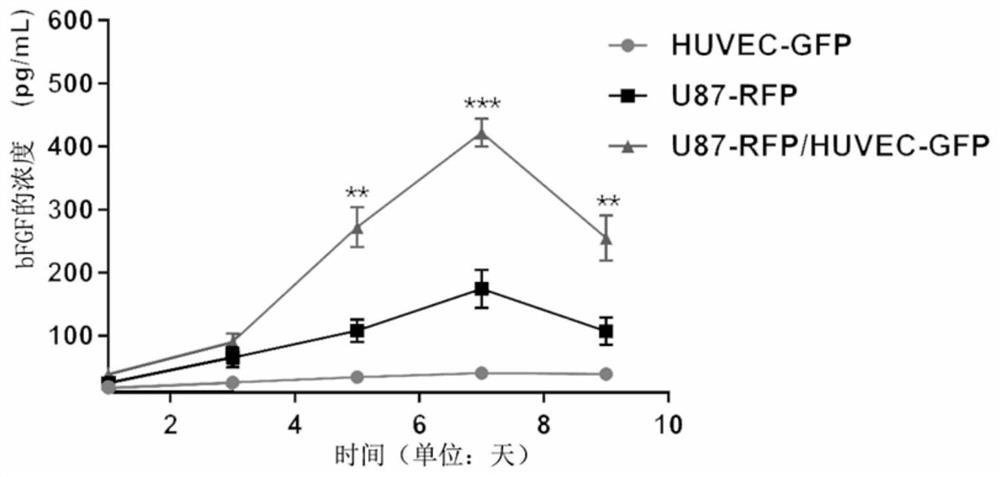Tumor angiogenesis model and its preparation method and application
A tumor angiogenesis and model technology, applied in the field of biological three-dimensional printing, can solve problems such as defects, uneven distribution of tumor cells, and contact inhibition
- Summary
- Abstract
- Description
- Claims
- Application Information
AI Technical Summary
Problems solved by technology
Method used
Image
Examples
preparation example Construction
[0123] In the , the present invention also provides a method for preparing the tumor angiogenesis model according to the , the tumor angiogenesis model includes hydrogel microfibers, and the hydrogel microfibers Be the structure of columnar body, wherein, the preparation method of described hydrogel microfiber comprises the steps:
[0124] Raw material preparation step: preparing a first hydrogel solution and a second hydrogel solution respectively, wherein the first hydrogel solution contains a first hydrogel material, and the first hydrogel material is loaded with tumors cells; the second hydrogel solution contains a second hydrogel material;
[0125] Printing step: using bioprinting technology to print the first hydrogel solution as a shell structure, and print the second hydrogel solution as a core structure, the shell structure is in contact with the core structure, and the shell structure is located at the radially outside the core structure.
[0126] Wherein, the firs...
Embodiment 1
[0186] Human glioma cells U87 and human umbilical vein endothelial cells HUVEC were cultured in complete medium, and the two cells were collected for transfection experiments when they were in the logarithmic growth phase. Prepare 3 × 10 with complete medium 4 / mL of cell suspension, according to the growth rate of each cell, add 1×10 4 cells, cultured at 37°C for 24 hours, and when the confluence of the cells reached 30%, 2 μL of 1×10 8 TU / mL virus infection solution mediating RFP or GFP gene, wherein, adding virus infection solution mediating RFP gene to human glioma cell U87; adding virus mediating GFP gene to human umbilical vein endothelial cells HUVEC The infection solution was cultured at 37°C for 16 hours, and the culture medium was replaced to continue the culture; human glioma cell U87-RFP cell suspension and human umbilical vein endothelial cell HUVEC-GFP cell suspension were respectively obtained.
[0187] After 72 hours of infection, observe the infection effici...
Embodiment 2
[0193] Human glioma cell U118 and human brain microvascular endothelial cell HBMEC were respectively cultured in complete medium, and were collected for transfection experiments when the two cells were in the logarithmic growth phase. Prepare 4 × 10 with complete medium 4 / mL of cell suspension, according to the growth rate of each cell, add 2×10 4 cells, cultured at 37°C for 24 hours, and when the confluence of the cells reached 20%, 3 μL of 1×10 8TU / mL virus infection solution mediating RFP or GFP gene, wherein, adding virus infection solution mediating RFP gene to human glioma cell U118; adding virus mediating GFP gene to human brain microvascular endothelial cells HBMEC The infection solution was cultured at 37°C for 14 hours, and the culture medium was replaced to continue the culture; human glioma cell U118-RFP cell suspension and human brain microvascular endothelial cell HBMEC-GFP cell suspension were respectively obtained.
[0194] After 72 hours of infection, obser...
PUM
| Property | Measurement | Unit |
|---|---|---|
| thickness | aaaaa | aaaaa |
| thickness | aaaaa | aaaaa |
| thickness | aaaaa | aaaaa |
Abstract
Description
Claims
Application Information
 Login to View More
Login to View More - R&D
- Intellectual Property
- Life Sciences
- Materials
- Tech Scout
- Unparalleled Data Quality
- Higher Quality Content
- 60% Fewer Hallucinations
Browse by: Latest US Patents, China's latest patents, Technical Efficacy Thesaurus, Application Domain, Technology Topic, Popular Technical Reports.
© 2025 PatSnap. All rights reserved.Legal|Privacy policy|Modern Slavery Act Transparency Statement|Sitemap|About US| Contact US: help@patsnap.com



